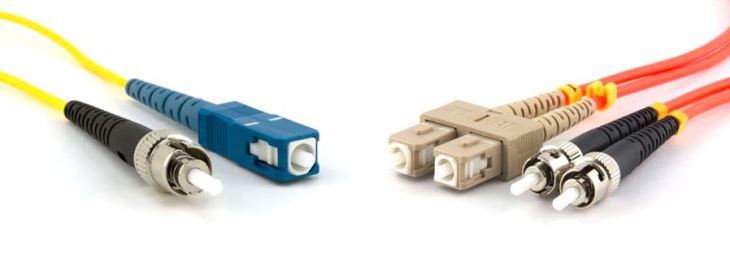
Simplex and duplex fiber cables differ in many ways. They differ in terms of speed, performance, number of strands, and bandwidths. There are hundreds of fiber optic cables, each differing from others in their cost, formation, and performance. Fiber optic cables are replacing the traditional and old network cables intending to improve signal transmission speed and reliability.
In every data transmission, two entities are involved; these entities are the sender and the receiver. The communication between these two entities will be either single-mode or multimode. These transmission modes use different types of fiber cables to achieve their objectives.
The article below will discuss some of the cable types that make different communication modes and signal transmission possible.
The main difference between Simplex and Duplex fiber cable
Below are the key differences between simplex and duplex fiber cables.
1. Fiber strand
One of the main differences between simple and duplex fiber optic cables is the number of strands in the cables. Simplex fiber cables use a single strand of fiber, and on the other hand, duplex fiber cables use multiple strands or two strands of fiber.
2. Direction of transmission
In simplex fiber cable, the transmission of data or the signal is single-mode, or we can say it is one-way communication of two ends. In contrast, duplex fiber cables transmit data and receive the data too. They are multi-directional and simple cables are uni-directional.
3. Cost of the cable
Simplex fiber cables are less expensive as compared to duplex fiber cable due to several reasons. One of the main reasons is that simplex cable use a single fiber strand and uses less material. In contrast, duplex fiber cable uses multiple strands and much material for their formation and transmission of the signal.
4. Cable performance
Duplex cables perform better in signal transmission in contrast to the simplex fiber cables. It is because duplex cables use multiple strands of fiber, which results in increased bandwidths. For the fibers to perform better, their installation also matters a lot along with the bandwidths. Consult fiber optic cable Dubai to install fiber cables to your networks without making any major mistakes that would later lead to network failure.
Types of duplex fiber cable
A duplex fiber has two types according to the type of data and signals transmission. Below is the detail of duplex fiber types with their differences.
1. Half-duplex cable
In half-duplex cables, the transmission of the signal is multimode. It means that both the sender and receiver can send the data. But the transmission of signals between the two ends will not be simultaneous; rather, the signal will transmit one at a time.
2. Full-duplex cable
Full-duplex cables are also multimode cables, and the transmission of data or signals is fast compared to half-duplex fiber cables. The sender and receiver that uses a full-duplex fiber cable can communicate simultaneously without facing any traffic or collision issues.
Advantages of full-duplex over half-duplex
Most of the applications and pieces of equipment using half-duplex fiber cables are no longer used by the people or the organizations. It is because of the advantages of full-duplex fiber cables that have improved the networks’ speed and performance.
Below are a few reasons why one should use a full-duplex fiber cable over a half-duplex fiber cable.
1. Performance and speed
Half-duplex cables are slow, and their performance is not effective. It is because the transmission of signals between two ends is not simultaneous. The sender sends a signal or data, and the receiver will send back data after it receives the signal from the sender. There is no way that the sender and receiver can communicate simultaneously. On the other hand, a full-duplex allows the sender and receiver to transmit signals simultaneously without waiting for a signal from each end.
2. Double bandwidths
In half-duplex, the bandwidth is limited, and on the other hand, full-duplex has a double bandwidth. Having higher bandwidths means high data and signal transmission rates. These higher bandwidths result in the improved performance and speed of full-duplex fiber cables.
3. Traffic and collision issues
Half-duplex fiber optic cables have higher rates of traffic and collision issues. The sender and the receiver both use the same lane or path to transmit the data, so there are chances that the sender and receiver send data that may collide on the way of transmission. For avoiding and handling these collisions, a controller called CSMA/CD is necessary for half-duplex cables.
Whereas full-duplex has no traffic or collision issues as the data transmission lanes for the sender and receiver are different.
Why prefer half-duplex sometimes?
There are a few reasons due to which using a half-duplex cable is good sometimes. As full-duplex cables are expensive, avoiding extra cost, half-duplex cables are ok to use. Apart from the cost factor in half-duplex, the whole bandwidth is assigned either to the sender or receiver while the other is waiting; this way, sending signals to longer distances becomes easier.
For using the type of duplex fiber, it is necessary to know your needs and requirements; without getting familiar with your cable need, you will not get optimal results. Hire the services of fiber optic cable Dubai to know what type of cable you need for your network and how to install the selected cable to your network to enjoy the full bandwidths for data transmission.
Read about : Top 4 advantages of smart home automation
Make the right cable choice according to your needs
You will find numerous types of cables that may serve different objectives, but for you, it is important to get familiar with your objectives and then select the type of cable that will help attain those objectives. If you are spending money on implementing the fiber cable, then select the right and suitable cable.






